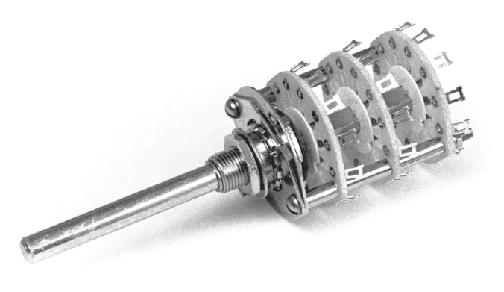
Rotary switch
Encyclopedia
A rotary switch
is a switch operated by rotation. These are often chosen when more than 2 positions are needed, such as a three-speed fan
or a CB radio with multiple frequencies
of reception or "channels".
 A rotary switch consists of a spindle
A rotary switch consists of a spindle
or "rotor" that has a contact arm or "spoke" which projects from its surface like a cam. It has an array of terminals, arranged in a circle around the rotor, each of which serves as a contact for the "spoke" through which any one of a number of different electrical circuits can be connected to the rotor. The switch is layered to allow the use of multiple poles, each layer is equivalent to one pole. Usually such a switch has a detent
mechanism so it "clicks" from one active position to another rather than stalls in an intermediate position. Thus a rotary switch provides greater pole and throw capabilities than simpler switches do.
Rotary switches were used as channel selector
s on television receivers until the early 1970s, as range selectors on electrical metering equipment, as band selectors on multi-band radios, etc.
Modern rotary switches utilise a "star wheel" mechanism to provide the switching positions. 30,45,60 or 90 degrees. Nylon cams are then mounted behind this mechanism and spring-loaded electrical contacts slide around these cams. The cams are notched or cut where the contact should close in order to make an electrical circuit.
Some rotary switches are user configurable in relation to the number of positions. A special toothed washer that sits below the holding nut can be positioned so that the tooth is inserted into one of a number of slots in a way that limits the number of positions available for selection. For example, if only four positions are required on a twelve position switch, the washer can be positioned so that only four switching positions can be selected when in use.
Switch
In electronics, a switch is an electrical component that can break an electrical circuit, interrupting the current or diverting it from one conductor to another....
is a switch operated by rotation. These are often chosen when more than 2 positions are needed, such as a three-speed fan
Fan (implement)
A hand-held fan is an implement used to induce an airflow for the purpose of cooling or refreshing oneself. Any broad, flat surface waved back-and-forth will create a small airflow and therefore can be considered a rudimentary fan...
or a CB radio with multiple frequencies
Frequency
Frequency is the number of occurrences of a repeating event per unit time. It is also referred to as temporal frequency.The period is the duration of one cycle in a repeating event, so the period is the reciprocal of the frequency...
of reception or "channels".

Spindle (tool)
In machine tools, a spindle is a rotating axis of the machine, which often has a shaft at its heart. The shaft itself is called a spindle, but also, in shop-floor practice, the word often is used metonymically to refer to the entire rotary unit, including not only the shaft itself, but its bearings...
or "rotor" that has a contact arm or "spoke" which projects from its surface like a cam. It has an array of terminals, arranged in a circle around the rotor, each of which serves as a contact for the "spoke" through which any one of a number of different electrical circuits can be connected to the rotor. The switch is layered to allow the use of multiple poles, each layer is equivalent to one pole. Usually such a switch has a detent
Detent
Detent is the term for a method, as well as the actual device, used to mechanically resist or arrest the rotation of a wheel, axle or spindle....
mechanism so it "clicks" from one active position to another rather than stalls in an intermediate position. Thus a rotary switch provides greater pole and throw capabilities than simpler switches do.
Rotary switches were used as channel selector
Selector
A selector can be:*"Selector" music scheduling software for radio stations created by Radio Computing Services*Selector , a Reggae DJ *A DNA probe used in the selector-technique...
s on television receivers until the early 1970s, as range selectors on electrical metering equipment, as band selectors on multi-band radios, etc.
Modern rotary switches utilise a "star wheel" mechanism to provide the switching positions. 30,45,60 or 90 degrees. Nylon cams are then mounted behind this mechanism and spring-loaded electrical contacts slide around these cams. The cams are notched or cut where the contact should close in order to make an electrical circuit.
Some rotary switches are user configurable in relation to the number of positions. A special toothed washer that sits below the holding nut can be positioned so that the tooth is inserted into one of a number of slots in a way that limits the number of positions available for selection. For example, if only four positions are required on a twelve position switch, the washer can be positioned so that only four switching positions can be selected when in use.

